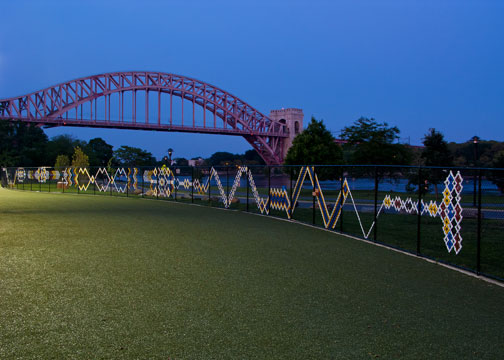Leah Oates: What was your background, and what has been your progression as an artist? Were there any creative types in your family, and when did you know you were going to be an artist?
Katherine Daniels: I grew up in Huntington, West Virginia. I was always drawing. As I was bad at sports and was also dyslexic, my parents really nurtured my interest in art. My mom knits and sews beautifully, so I saw how her hands were always busy and how she chose projects and colors.
There was a lady named Ruth Ettling in my church who was a fairly well-known artist. She made beautiful prints and collages. I got to visit her studio when I was in high school, and I remember wanting to have a studio like hers. She went to Rhode Island School of Design and was thrilled for me when I was accepted to go to college there.
I studied painting because I wanted to master color, but I’ve evolved into a sculptor. Now I make this hybrid between painting and sculpture where I build surfaces of color with weaving, sewing, and beading instead of paint.
LO: Please explain the themes in your work as well as your working process. For instance, some artists are very methodical while others are more instinctive. Please elaborate.
KD: The idea of a garden in paradise influences the organic abstractions I make. I worked at the Metropolitan Museum of Art for many years in Asian and Islamic art, and that time deeply influenced my work. The symmetry in jewelry from India, the balance between realism and abstraction in Japanese screens, and the beauty and fantasy of the borders in Persian paintings really connected with me.
I work instinctively but in a very orderly and organized manner. I organize my materials so that I have a sense of color, scale, and a goal of what I want to accomplish, and then I dive in.
LO: You are a painter, sculptor and also create public works. Are there any differences with each way of working?
KD: I approach each medium differently.
With painting, I have an idea about a size, palette, and compositional approach, but it’s pretty loose. I usually can’t articulate what I am doing in a piece until after I’ve done it.
With sculptures and installations, I usually gather together materials that I want to work with and start organizing the colors and forms until I develop a compositional plan.
I can usually say what direction I’m going in if not the final destination.
With public work, the site rules all of those elements. I look at the site and try to imagine how I can bring my visual voice to the space, history, and requirements of the place.
Public art requires that you fully articulate what you’re going to do before you find out if you are going to get the opportunity.
LO: Who are your favorite artists and why?
KD: I love Calder’s use of color and play, Lee Bontecou’s articulation of nature and abstraction, the way Kiki Smith and Louise Bourgeois use materials. Judy Pfaff’s compositions are so dynamic. Having worked at the Met, I developed a long, close relationship with the collection there. The Tiepelos at the top of the main staircase blow me away every time I see them; I’m awed by the color and compositional dynamism of those paintings.
LO: What advice would you give younger artists on how to mark success as an artist? Success seems to be marked by big galleries making big money. Do you think that there are other ways to mark success as an artist?
KD: Not everyone is going to get rich or even get by, and very few artists will always be “hot stuff.” My advice: commit to a life of making art, with success being measured by your satisfaction with a piece or body of work. Make making art and building a body of work the priority; then, you need to find a balance in which you are creating the work, showing it, and engaging with the art world outside of your studio.
























